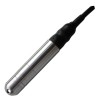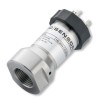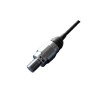Wheatstone bridge strain gauge circuits are used extensively inside transducer to convert a mechanical strain into an electrical output signal.
The basic circuit consists of four resistive elements which are connected together into a diamond shaped configuration. Typically all 4 resistive elements are active strain gauges to maximise sensitivity of the transducer but in some cases 2 fixed resistors are used with 2 strain gauges instead.
A Wheatstone bridge strain gauge circuit is created by mounting a pair of strain gauges on a material that will be stressed, so that when a force is applied, they will stretch along their width. Another pair of identical strain gauges are mounted in a direction at 90° to the other pair, where the applied force will stretch them along their length.
The simplest way to achieve the wheatstone bridge configuration is to mount all four strain gauges onto the measurement surface in a radial configuration separated by 90 degrees, with all strain gauges pointing in the same direction.
Featured strain gauge based measurement products
 Ceramic Thick Film Pressure Sensors - This is a type of sensor which utilises a measurement technology that comprises of a ceramic diaphragm and thick film strain gauges to measure pressure.
Ceramic Thick Film Pressure Sensors - This is a type of sensor which utilises a measurement technology that comprises of a ceramic diaphragm and thick film strain gauges to measure pressure. IMCL Submersible Absolute Reference Depth Sensor - Absolute reference hydrostatic depth sensor with an IP68 sealed electrical interface, SS316L, Duplex or PVC housing and a mV, voltage or current output.
IMCL Submersible Absolute Reference Depth Sensor - Absolute reference hydrostatic depth sensor with an IP68 sealed electrical interface, SS316L, Duplex or PVC housing and a mV, voltage or current output.
The two strain gauges that are pointing tangentially will be stretched across their width which will decrease the resistance. The other two strain gauges which are pointing radially will be stretched along their length which will increase the resistance.
Each strain gauges is then connected to the next one to form a diamond shape, and the points of the diamond become the connection points providing power to the circuit and for measuring the signal generated.
If a voltage supply is then applied across two opposite connection points of the Wheatstone bridge circuit, and a voltmeter is connected to the remaining two opposite connection points, a voltage drop will be detected which will vary depending on the stress applied to the surface that the wheatstone bridge circuit is mounted.
Featured strain gauge based measurement products
 Yacht fuel tank hydrostatic transmitter to replace float level sensors on shallow tanks - Replacing unreliable float switches in a yacht's diesel tank? See how an IP68-rated submersible pressure transducer with FKM seals and a 316L diaphragm provided a robust and accurate solution.
Yacht fuel tank hydrostatic transmitter to replace float level sensors on shallow tanks - Replacing unreliable float switches in a yacht's diesel tank? See how an IP68-rated submersible pressure transducer with FKM seals and a 316L diaphragm provided a robust and accurate solution. DMP334 Hydraulic Pressure Transducer for Very High Pressures - DMP 334 is a high range pressure transducer designed for measuring hydraulic pressures up to 2200 bar (32,000 psi) .
DMP334 Hydraulic Pressure Transducer for Very High Pressures - DMP 334 is a high range pressure transducer designed for measuring hydraulic pressures up to 2200 bar (32,000 psi) .
Help
I have red, black and white leads from strain gauges (SG) on the compression side of a cantilever beam. The resistance between the red & white lead and the black & red lead is 1K ohm. The resistance between the black & white lead is 2K ohms. How are the leads connected to the Wheatstone Bridge (WSB)? Are there 2 WSB’s? How do they connect? Please show a circuit diagram which has all four beam SG’s connected to a bridge and these to output circuit. Please identify typical discrete labeled components for an output of 0-5V.
A wheatstone bridge typically has 4 strain gauges (see diagram above), of which 2 are under compression (C) and 2 are under tension (T). A circuit is formed by joining the strain gauges together end to end to create a loop in this order
C1 ↔ e ↔ T1 ↔ f ↔ C2 ↔ g ↔ T2 ↔ h ↔ C1.
If point ‘e’ is connected to a positive supply (supp+) and ‘g’ is connected to a negative supply (supp-), an equal current will flow through both sides of the loop if each of the strain gauges have equal resistance witout any strain applied.
If a strain is applied to the strain gauges, the resistance in C1 and C2 will reduce and T1 and T2 will increase. This create an imbalance between points ‘f’ and ‘h’ creating a potential difference (Vout) which is proportional to applied strain.
The output from a wheatstone bridge strain gauge circuit is typically a low voltage signal measured in millivolts. Therefore it is necessary to amplify the millivolt output with a strain gauge signal conditioning unit to generate an output of 0-5V.
Featured strain gauge based measurement products
 Multi-point wireless pressure sensing for end-of-line vehicle brake testing - 5-channel wireless sensing solution for simultaneous brake reservoir pressure testing, integrating directly with existing PLCs via analog outputs.
Multi-point wireless pressure sensing for end-of-line vehicle brake testing - 5-channel wireless sensing solution for simultaneous brake reservoir pressure testing, integrating directly with existing PLCs via analog outputs. ASM 13mm Diameter Miniature Pressure Transducer - Miniature size 1/2 inch diameter stainless steel pressure sensor with an amplified 0.5 to 4.5 Vdc output. Pressure ranges start from 10 up to 400 bar.
ASM 13mm Diameter Miniature Pressure Transducer - Miniature size 1/2 inch diameter stainless steel pressure sensor with an amplified 0.5 to 4.5 Vdc output. Pressure ranges start from 10 up to 400 bar.
Glossary of Sensor Technology technical terms
- BFSG – Bonded Foil Strain Gauge
- Bourdon Tube
- Capacitive Fluid Level Measurement
- Ceramic Pressure Sensors
- Conductive Fluid Level Detection
- Doppler Effect Flow Measurement
- Float Fluid Level Detection
- LVDT – Linear Variable Differential Transformer
- Paddle Wheel Sensor
- Piezoresistive Strain Gauges
- Positive Displacement Flow Measurement
- Radar Distance Sensing
- SOI – Silicon on Insulator
- Strain Gauge
- Thin Film
- Transit Time Flow Measurement
- Turbine Rotor Sensor
- Ultrasonic Distance Sensing
- Ultrasonic Flow Velocity Sensors
- Vibrating Tuning Fork Fluid Level Detection
- Vortex Flow Measurement



